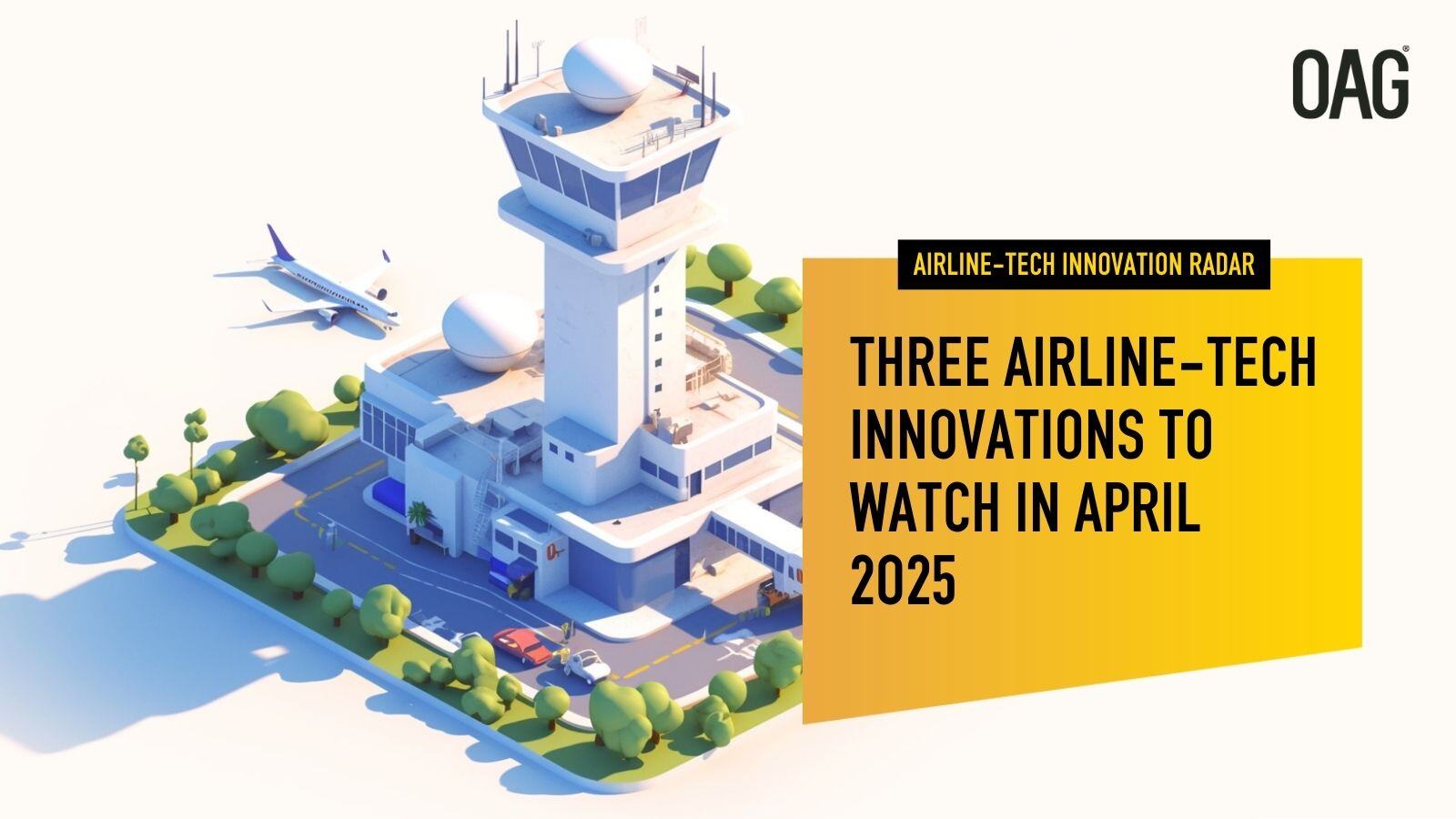The airline industry is currently navigating a period of heightened uncertainty. Geopolitical tensions, especially the ongoing tariff discussions, are casting a shadow over the global outlook, and early demand signals reflect growing traveler caution. But while these short-term headwinds are real, they shouldn’t distract us from the longer-term digital transformation of the airline sector, especially the innovation momentum still gaining speed beneath the surface.
This month, we spotlight three major innovation launches that give us renewed confidence in aviation’s long-term future. Let’s dive into April’s standout innovations:
Innovation #1: Google Doubles Down on AI for Travel Planning
Google is making a bold push into the travel planning space by rolling out a suite of AI-powered features across its core platforms: Search, Maps, and Gemini. The new tools aim to simplify the way people research, plan, and organize trips, offering a more seamless and integrated experience across the Google ecosystem.
Here’s how it works:
One of the biggest updates comes to Google Search, where so-called “AI Overviews”—the new summaries generated by Google’s large language models—can now help users create full trip itineraries.
- For example, a traveler can type “create an itinerary for Costa Rica with a focus on nature” and instantly receive a full, interactive trip suggestion, complete with photos, reviews, and an expandable map view.
- Users can then export the itinerary into Google Docs or Gmail to share it with friends or save it directly in Google Maps as a custom list of places.
Meanwhile, Gemini, Google’s AI assistant, is getting a major travel update as well. Through “Gemini Gems,” users can create customized “mini travel planners” for free.
- These personalized agents can help pick destinations, suggest what to pack, and even offer ongoing trip support.
- On top of that, hotel price tracking alerts are being integrated into Search, and users will now be able to turn screenshots of places into saved locations in Google Maps, closing the loop from inspiration to action.
Why does this innovation stand out?
The real power of this innovation lies not in any single feature but in how Google is stitching together its entire platform into a travel planning ecosystem. By connecting Search, Maps, Gemini, Gmail, and Docs, Google is taking steps to become the ultimate “super app,” or rather “super-platform,” for travel, something OTAs and other AI-native tools like ChatGPT would not be able to offer.
Crucially, Google’s approach isn’t just about simplifying inspiration and booking. Features like Gemini Gems point to a future where travel-specific AI agents, customizable by anyone, could become a powerful new layer of user interaction, essentially allowing every traveler to build their own digital travel concierge.
For airlines, OTAs, and other industry players, this is a development worth watching. Google is quietly redefining what the travel planning journey might look like, and it’s happening inside existing tools that billions of people already use every day.

Innovation #2: Japan Airlines Simplifies Crew Operations with its AI-Powered Reporting App
There’s clearly no slowdown when it comes to AI in travel. While much of the recent attention has focused on customer-facing enhancements, like Google’s new trip planning tools, just as much innovation is happening behind the scenes, transforming the operational backbone of aviation.
Japan Airlines offers a prime example of this shift. The carrier is building “JAL-AI Report,” an AI-powered mobile app that streamlines the post-flight reporting process for its cabin crew—a task that, until now, has been both time-consuming and labor-intensive.
Here’s how it works:
After each flight, flight attendants are responsible for writing incident reports. These summaries of notable events onboard can include medical emergencies, unruly passenger behavior, or equipment malfunctions. These reports are vital for compliance, safety reviews, and continuous service improvement, but they’re also quite time-consuming. Historically, they could take up to an hour per flight to complete.
Japan Airlines, in collaboration with Microsoft, is looking to change that.
The new JAL-AI Report app is powered by Microsoft’s Phi‑4 small language model (SLM). It is a compact, efficient model specifically chosen for its ability to function offline and on mobile devices with limited computing power. This is crucial for in-flight use or scenarios with poor connectivity. Early trials suggest the app can cut report writing time from 60 minutes to just 20 minutes.
Additional features are also in the works:
- Soon, the app will allow flight attendants to dictate reports or even convert relevant conversations with colleagues and passengers into structured input for AI-generated reports.
- With one tap, attendants can convert Japanese reports into English, an essential tool on international flights and an additional major time saver.
Why does this innovation stand out?
Unlike many AI projects that feel more like PR moves than operational breakthroughs, Japan Airlines’ JAL-AI Report tackles a real-world airline challenge with clear productivity gains. It reduces repetitive admin work and allows crew members to spend more time where it matters most: caring for passengers.
This is AI at its most business-relevant: improving efficiency, employee satisfaction, and, ultimately, the customer experience.
Equally important, JAL’s thoughtful approach reveals a side of the AI conversation that’s often overlooked: infrastructure constraints. By opting for a small language model that works offline and on mobile, the airline is solving real deployment challenges that come with applying AI in aviation environments—not everything can be solved with a cloud-based LLM.
In short, this is a practical innovation with tangible results and a great case study in designing AI not for hype, but for high-impact operational use.

Innovation #3: Air India Tackles Accessibility with Real-Time Wheelchair Tracking
Not every breakthrough in aviation tech requires sophisticated AI or massive LLM integrations. Sometimes, simple digital platforms can have an outsized impact, especially in the operational trenches of air travel. Innovation #3 is a powerful reminder of that.
Air India, in partnership with AISATS and Rsmart, has rolled out a digital management system to better serve passengers with reduced mobility (PRM). The goal? Real-time tracking and optimized allocation of wheelchair resources at the airport.
Here’s how it works:
- The system is surprisingly straightforward but effective. It enables live visibility of all available wheelchairs across the airport, directly on mobile devices used by ground staff.
- As flight schedules change, gates shift, or demand fluctuates, the tool allows for dynamic reallocation of wheelchair assistance, ensuring passengers get support when and where they need it. It’s a modern dispatch system built for a very specific, yet critically important use case.
Why does this innovation stand out?
This is more than a tech upgrade, it’s a direct response to a real operational and reputational challenge.
Air India has come under public scrutiny twice in the past 13 months for failing to provide wheelchairs to passengers in time, most recently in an incident that ended with a passenger suffering a fall.
This solution addresses the airline’s own pain point, but it also reflects a much broader industry trend:
- With aging populations across many countries, the demand for mobility assistance at airports is rising rapidly.
- On long-haul flights out of India, it’s not uncommon to see 30–40 PRM requests per aircraft, and that number is only expected to grow.
This innovation offers two major benefits:
- Managing special assistance services more effectively ensures passengers with mobility needs are not left waiting or, worse, left behind.
- Delays caused by poor coordination for wheelchairs are more common than many think. A digital layer like this can reduce bottlenecks and ensure regulatory compliance while also boosting customer satisfaction.
What’s most impressive? It’s a “low-tech” solution solving a high-stakes problem, proving that not every digital innovation needs to be flashy to deliver meaningful results.

This closes out our April edition with a reminder: the path to better air travel lies not only in futuristic AI applications but also in practical, user-focused digital solutions that make aviation more efficient, inclusive, and human.
Keep informed, and join the Travel Tech Insights Newsletter by OAG on LinkedIn here.



